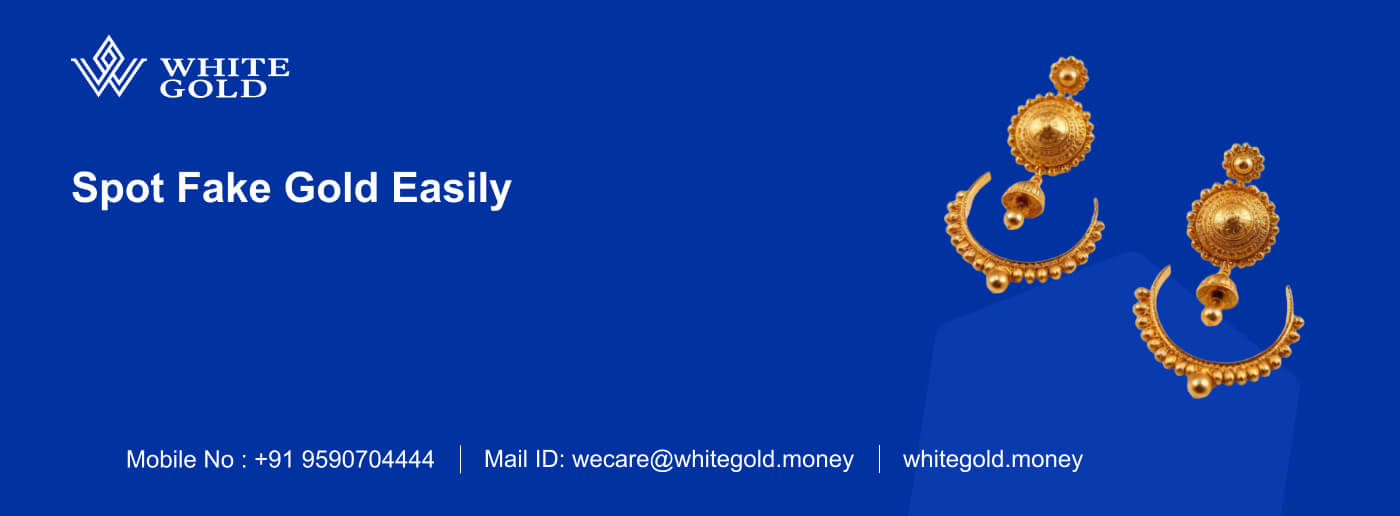How to Spot Fake Gold: A Guide for Sellers

5min read

Gold has been one of the most coveted metals of mankind since time immemorial due to its timelessness in appeal and value. Yet, that very reason for its high demand makes it a favored target for counterfeiting, too. Whether a seasoned dealer or new in the trade, one must know how to identify fake gold in order to protect his good name and ensure the successful closure of a deal. The guide shall help in deciphering how the authenticity of gold is verified while making the process of selling the same more safe and secure. In such a situation, dealing business with trusted gold buyers such as White Gold will ensure one sells his gold with ultimate confidence.
Why Identifying Fake Gold is Important
Faux gold is not only a nuisance but may cost you financially and further affect your reputation as a seller. The market is full of fake items that can easily pass by the untrained eye. However, with reputable gold buyers such as White Gold, one is assured of expert evaluations to identify and trade in real gold confidently. Our expertise and advanced tools are invaluable in selling gold in today’s competitive market.
Methods to Identify Fake Gold
Let’s look into some ways of telling actual golds apart from counterfeit ones.
Check Hallmarks
Solid gold pieces are usually stamped with hallmarks that denote fineness:
- When referring to karat, you must check for 24K, 22K, 18K, or 14K.
- 999, 916, 750, 585, or 417 are fineness indications in gold.
- While hallmarks are a good starting point, they can be faked. Cross-verify them with other tests before deciding to sell gold.
Magnet Test
Gold is not magnetic. You can perform a simple test:
- Place a magnet near the item. If it sticks, it’s probably fake.
- Note that this test may not be very reliable, as gold-plated items can easily pass the test; consider other methods to verify this.
Density Test
Gold is one of the most densest metals. In the case of checking density:
- Weigh the gold item.
- Allow it to sink in the water and then measure the volume of water it displaces.
- Calculate the density by dividing the weight by the volume. If it does not come anywhere close to the density of gold (~19.3 g/cm³), it is most likely fake.
- Check the Colour and Weight
Real gold has a distinctive look and feel. Fake items tend to:
- Look too bright or dull.
- Feel lighter than initially expected.
While selling gold, compare the item against real gold pieces so that you could avoid problems.
Scratch Test
Gold is a soft metal, and it leaves a characteristic mark. To make the test:
- Scratch the product on unglazed ceramic.
- Real gold leaves a golden streak whereas the fake materials leave black or green marks.
- Use this method with caution, especially for valuable pieces.
Acid Test
A test using nitric acid will prove the genuineness:
- Apply a drop on the piece of gold. Genuine gold remains unaffected, while fake items react by bubbling or discoloring.
- Although highly reliable, this test should be carefully conducted or preferably by professionals.
XRF Test – X-Ray Fluorescence (Advanced)
If you want the most accurate results, you may want to consider XRF testing. This is a non-destructive test that will tell you what metals your item is composed of.
Red Flags to Watch Out For
When buying gold, look out for the following warning signs:
- Suspicious Pricing: If an offer sounds too good to be true, it probably is.
- Lack of Documentation: Real gold is always accompanied by some form of certification.
- Poor craftsmanship, such as rough edges, an uneven design, or different color shades, often characterizes counterfeited goods.
Why White Gold Is Your Number One Companion in Selling Gold
Speaking of the smooth and fair selling process, White Gold is indeed a trusted name in this line of business. As experienced buyers in gold, with the use of XRF analysis among other advanced tools, we can do quite accurate evaluations. In such a case, by selling your gold to White Gold, you are sure you are getting the correct evaluations for the best value for your items.
White Gold’s professional approach allows the seller to easily and comfortably sell gold. A very clear process in which all explanations and prices are competitive enables any seller to trade confidently. Whether it be an item or a collection, White Gold ensures the selling experience is fair, secure, and reliable.
Final Thoughts
Identifying counterfeit gold requires a good understanding of knowledge, vigilance, and the right tools. Learn the skills needed to determine whether gold is counterfeit or genuine by:
- Examining the hallmark,
- Performing scratch or density tests, and
- Utilizing advanced XRF analytical technology.
Even if one is experienced, though one is using a reliable, trusted buyer like White Gold, each transaction is precisely as safe and secure as clockwork.
Whether one wants to sell gold, it is with White Gold that the experience will be smooth and rewarding. Our expertise and transparency guarantee that it can be trusted to take care of the seller.
Visit White Gold today to get full value for your gold and ensure that your selling journey is as genuine as the precious metal itself.







